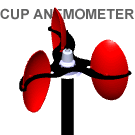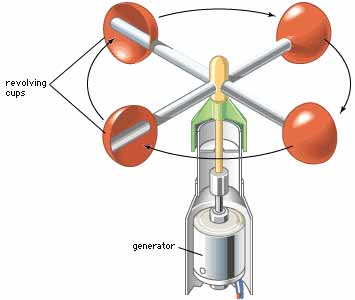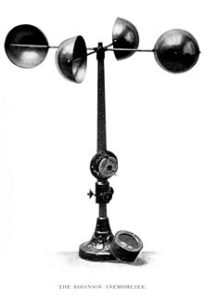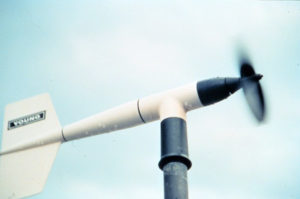Cup anemometers measure wind speed in a highly accurate way. We’ve gathered together all the information you need to know about cup anemometers, how they work, where to buy them and more. Skip down directly to our sections below: What is a cup anemometer How does a cup anemometer work? and factors to consider when purchasing an anemometer.
The best cup anemometer for sale
Magnetic Mount Anemometer Wind Meter by Inspeed
This is a popular wind cup anemometer which mounts to anything metal with its dual powerful magnet mounts on its base. It comes with a 25 foot long cable and a digital meter which allows you to measure the wind speed on its included display. Inspeed, the company that makes it, has designed this wind cup anemometer with the magnetic base so you can mount it on your vehicle for storm-chasing but of course you could also mount it at home on a sheet metal roof or anywhere else you have a metal surface to stick it to. For storm chasers or storm spotting in particular though, this is definitely one of the best cup anemometers out there because of its generous cable length allowing you to measure wind speed without getting out of your car (especially if its raining).
Pros: great car mounted anemometer for storm chasing
Cons: mounts magnetically only
Pole Mount Anemometer by Inspeed
If you’re looking for a wind cup anemometer but you want to mount it permanently or semi-permanently in a spot where a magnet like the car magnet anemometer above won’t work, this pole mount anemometer might be your best bet.
Inspeed’s anemometers are quite accurate, up to + or – 1 mile per hour and the included display captures both the maximum speed reached in a session as well as the current average. The battery in the remote display unit lasts for months of continuous use.
This wind cup anemometer comes with a digital display and a 25 foot cable, though you can attach your own 18 gauge speaker wire for a 100+ foot range which makes it easy to mount this anemometer on the roof of an RV or the roof of a house while the display is safely indoors. You can also bury the cable underground as well.
Pros: great mountable anemometer
Cons: not portable
Inspeed Vortex Handheld Anemometer
This Inspeed cup thermo-anemometer is a great portable wind cup speed meter that you can hold easily in your hand to measure wind speed anywhere you go. It’s a simple construction featuring three rotating wind cups and a pole that you hold. Measurements are taken with a Cateye Bicycle computer which can display current speed as well as the max and average speeds. This little guy is rugged though. It’s actually used by the CNN weather correspondent in the US Gulf Region for hurricane reporting as this anemometer can measure winds from 5 to 150 mph. When you’re done, it folds up compact for storage.
Pros: easily portable, handheld wind speed meter
Cons: price (perhaps)
AcuRite Pro 5-in-1 Weather Station
If you need a wind cup anemometer but you also want to measure other types of weather data as well at a fixed location, then an all in one unit like this AcuRite Weather Station might be just the ticket. It uses a range of instrumentation to provide you with your own personalized 12 to 24 hour weather condition forecast. This is especially useful for those of us that live in remote areas or places where weather forecasts are inaccurate due to a lack of weather instrumentation or those who live in microclimate zones that weather services don’t measure.
This sophisticated weather station with cup anemometer can measure the temperature, the wind speed and direction, rainfall in inches or millimeters, and other data. And it distills it all down to a forecast summary that can tell you if bad weather is on the way, as well as give you a “feels like” temperature.
The AcuRite Wireless Weather Station mounts on the side of a building such as a house and streams data to its included display up to 330 feet away (100 meters). It also gives you information about the day’s high and low as well as how much rainfall you’ve had and the time.
Pros: measures much more than just wind speed
Cons: complicated display
BTMETER Handheld Cup Anemometer
BTMETER makes an affordable handheld cup anemometer in a compact design. It takes the traditional 4-cup anemometer and shrinks it down to fit in a cage at the top of the reader. The main benefit of the cup anemometer design is it can measure wind from any direction. The compact size means it can easily be stored in a pocket or bag and used on the go. This model measures wind speeds from 1.5 to 93 mph in your choice of units (km/hr, Knots, m/s, mph). The built in 1.6″ LED display can give you current, maximum, and average wind speeds.
In addition to the wind meter, there is a compass built into the top of the reader to easily assess wind direction. The compact design makes the BTMeter great for sports like shooting, surfing, or sailing. Fishermen, hikers, and drone enthusiasts are also fans of this model.
Pros: Compact design
Cons: Powered by a coin battery which can be annoying to buy replacements of
Children’s Weather Station with Cup Anemometer
Looking to teach your kids or students about climate science or weather? This educational wind cup anemometer helps teach basic weather concepts.
This mini weather station measures wind speed using a cup anemometer with a built in weather vane to measure direction. If mounted outside, the built in rain gauge can help track precipitation. There’s also a simple thermometer for temperature measurements.
This weather station can be set up outside using a built in ground stake. It also includes an educational guide for teaching the basics of weather measurement.
Pros: Basic weather station for kids 8 years+
Cons: Needs to be set up outside to take advantage of rain gauge
Check out the best anemometers for kids and more weather gifts for kids.
What is a cup anemometer?
 Cup anemometer definition: Anemometers measure wind speed, and a cup anemometer is specific type of wind speed gauge that measures the speed of wind or air flow based on how quickly a set of cups turns around in a circle.
Cup anemometer definition: Anemometers measure wind speed, and a cup anemometer is specific type of wind speed gauge that measures the speed of wind or air flow based on how quickly a set of cups turns around in a circle.
Cup anemometers are one of the older types of anemometers or wind meters and they’re they’re still popular today among weather hobbyists and professionals measuring wind and weather. Cup anemometers are generally pretty accurate and they come in a few different varieties with the major difference being how many different cups they have (two, three or four) and whether or not they electronically count the revolutions per minute or whether you need to count them manually to measure wind speed. The cup anemometers that are manual and do not automatically count revolutions are generally meant for student use and not professional use. Often the manual count anemometers will have one cup that is a different color to help make it easier to count the number of revolutions the wind cups make per minute.
Cup anemometers will also sometimes come as part of a larger weather station with additional instruments. They also come in different form factors: some are designed to be mounted on the outside of buildings, others work well on top of a car, and still others are meant for handheld portable use.
Common wind cup anemometer users: home weather hobbyists, storm chasers/storm spotters, HVAC contractors, wind power professionals, windsurfers, sailboat owners.
Learn more about the different types of wind meters in our other article, what is an anemometer and what is it used for?
How does a cup anemometer work?
 As the wind is caught in each cup on a wind cup anemometer, it pushes the cup to rotate and catches the next cup in its path, making the cup spin. The number of revolutions per minute will determine how fast or strong the wind is blowing. Some wind cup meters require you to manually count the revolutions per minute to discover the wind speed; other wind cup speed meters will measure the wind speed digitally and calculate it for you by counting the rotations on an internal computer.
As the wind is caught in each cup on a wind cup anemometer, it pushes the cup to rotate and catches the next cup in its path, making the cup spin. The number of revolutions per minute will determine how fast or strong the wind is blowing. Some wind cup meters require you to manually count the revolutions per minute to discover the wind speed; other wind cup speed meters will measure the wind speed digitally and calculate it for you by counting the rotations on an internal computer.
A wind cup anemometer is a relatively basic but still fairly accurate wind instrument from a scientific point of view. They are in common use at weather stations around the world and points of interest where wind velocity is extremely important to understand such as airports. They are also used by wind power professionals who are evaluating sites for potential turbine installation.
Factors to consider when buying a rotating cup anemometer
Does this cup anemometer have a digital readout or will I need to manually count revolutions? This is a pretty obvious question and in most cases most people will require an anemometer with a wind calculator built in. One exception may be science teachers or those looking for a weather related gift for a child.
Is this cup anemometer handheld or mount-able? Some cup wind meters are meant to be mounted on cars or buildings or poles, and others can be brought with you wherever you go.
Does this mountable anemometer have a wired or wireless display? If you’re looking to use an anemometer mounted on your vehicle or outside of your home you may be especially interested in getting a wireless anemometer with a decent range to it so you can measure the wind speed without having to have a cable hooked to your device outdoors. Some rotating cup anemometers have wireless displays that can be placed hundreds of feet away and others require a cable to go from the wind cups to the display indoors. Regardless of whether or not your anemometer is wired or wireless, you’ll want to check the maximum range or cable length of the display you’re considering.
How many cups does this anemometer have? Cup anemometers come with a variety of different cup counts: some are 2 cup anemometers, others are 3 cup anemometers and still others have 4 cups.
Do I want a cup type anemometer that has logging built in? If you’re interested in logging wind velocity, you may be particularly interested in a cup anemometer which works with your smartphone so the wind speeds you measure can be logged with time and location.
Do I only care about measuring wind speed or do I want other features and functions too? If you’re interested in more than just wind velocity, you may want to consider fully fledged personal weather stations that include wind cups but also measure factors like temperature, barometric pressure, rainfall, humidity and other factors. These personal weather stations can accurately predict rain and weather conditions using a variety of instruments and often come with wireless digital displays that you can keep in your home.
Learn how to make a DIY cup anemometer.
Check out the best portable wind meters.






 An anemometer is a weather monitor instrument used to measure wind speed. The first crude anemometers were used to roughly measure wind speed hundreds of years ago, but today anemometers are highly accurate wind speed monitors that can provide data in a variety of ways.
An anemometer is a weather monitor instrument used to measure wind speed. The first crude anemometers were used to roughly measure wind speed hundreds of years ago, but today anemometers are highly accurate wind speed monitors that can provide data in a variety of ways.
